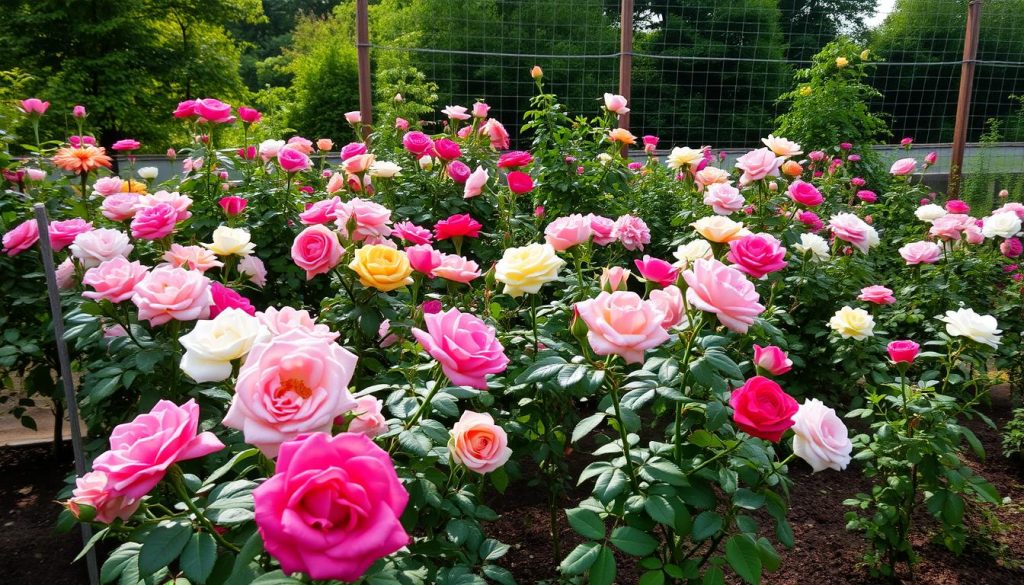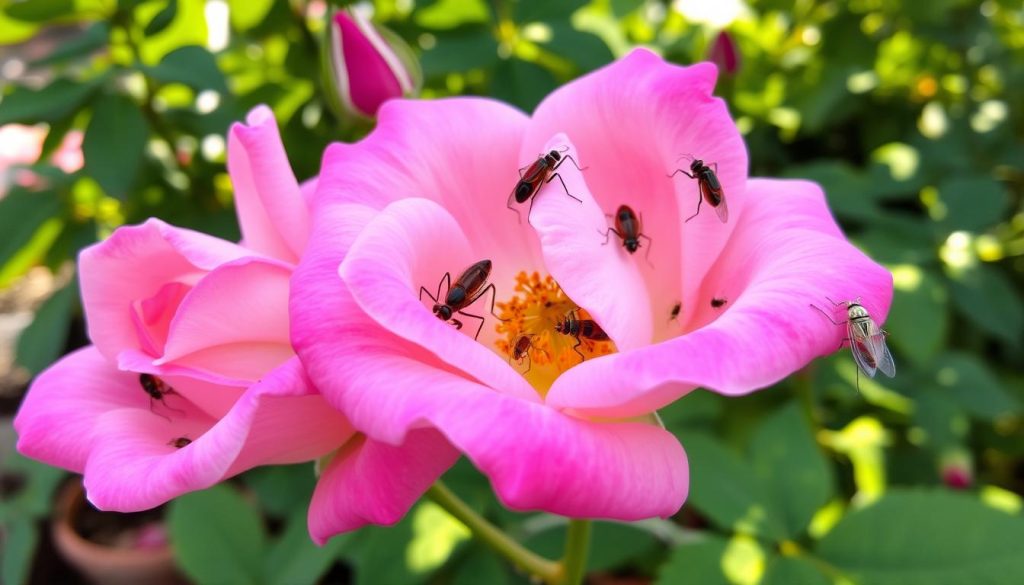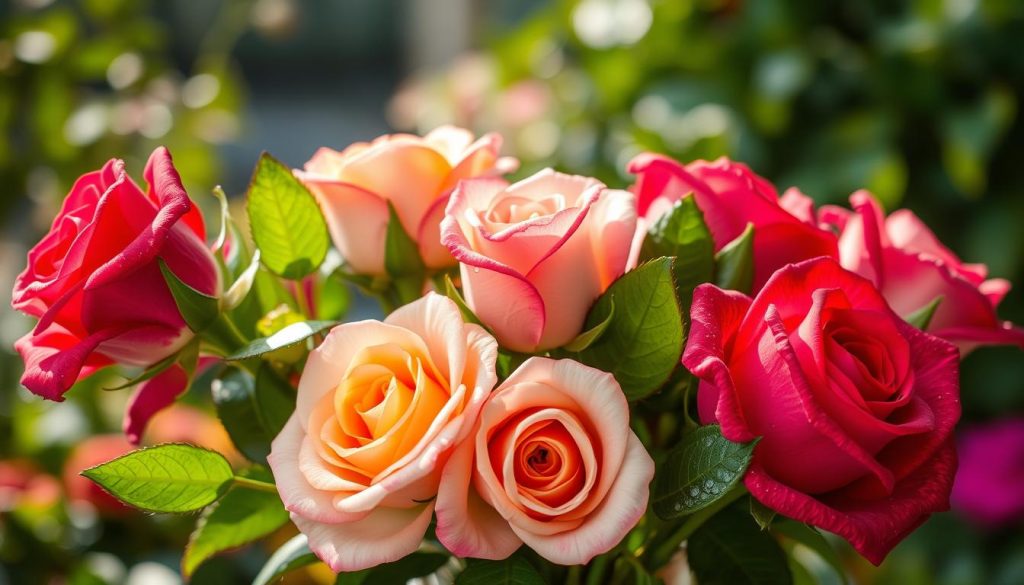Creating a thriving rose garden is easier than you think. Even beginners can grow stunning roses with the right care. These tips will help you grow healthy, vibrant roses in the ground or containers.
Roses need 6-8 hours of sunlight daily and well-drained soil. Water them at the roots, not overhead, to avoid diseases. Regular pruning keeps the plant healthy, encourages growth, and improves air flow.

Key Takeaways
- Roses need 6-8 hours of daily sunlight and well-drained, nutrient-rich soil
- Water roses at the root zone to prevent fungal diseases
- Prune roses regularly to maintain shape, encourage growth, and improve air circulation
- Monitor for pests and diseases, and take prompt action to address any issues
- Incorporate disease-resistant rose varieties to minimize maintenance
Understanding Different Types of Roses
The rose family (Rosa) has many varieties, each with its own look and growth pattern. From the classic hybrid tea rose to the hardy shrub rose, there’s a rose for every garden. Let’s look at some popular rose types to find the perfect one for your outdoor space.
Container Roses vs. Bare-Root Roses
When planting roses, you can choose between container roses and bare-root roses. Container roses are easy to plant and grow fast, great for new gardeners. Bare-root roses offer more choices but need more care at first.
Popular Rose Varieties for Beginners
- Hybrid tea roses: Known for their large, ornate blooms and long stems, these are among the most popular roses for landscaping.
- Floribunda roses: Bushy with abundant flowers held in clusters, floribundas are a hardy and low-maintenance option.
- Shrub roses: Offering a sprawling growth habit, cold hardiness, and abundant flower production, shrub roses are an excellent choice for landscape design.
Climbing and Shrub Rose Varieties
For gardeners looking for vertical interest, climbing roses and shrub rose varieties are great. Climbing roses, like ‘Kiftsgate’ and ‘Madame Grégoire Staechelin’, can be trained to cover pergolas or walls. Shrub roses, like the disease-resistant ‘Julia Child’ and the fragrant ‘Teasing Georgia’, are easy to care for and perfect for borders and foundation plantings.
Choose rose varieties that fit your local climate and growing conditions for the best results.
Selecting the Perfect Location for Your Roses
Choosing the right spot for your roses is key. They love areas with 6-8 hours of direct sunlight daily. In warmer places, give them some shade in the afternoon to avoid sunburn.
The soil should drain well and be rich in organic matter. Roses don’t do well in wet or tight soil.
In colder areas, plant roses near fences or walls facing south or west. This helps protect them from harsh winter winds. Also, make sure there’s good air flow to prevent moisture buildup and diseases.
Roses fit well in mixed gardens or dedicated rose gardens. Space them correctly to ensure air flow and growth. This keeps your rose garden healthy and vibrant.
Choosing the right spot for your roses is crucial for their success. The best spot combines good sunlight, drainage, and air flow. This way, your roses will bloom beautifully every year.
Essential Rose Gardening Equipment and Tools
Successful rose gardening needs the right tools and equipment. This ensures your plants stay healthy and vibrant. From pruning shears to watering devices, the right tools are key to stunning rose blooms.
Pruning Tools and Safety Gear
Pruning is vital in rose care. The right tools make the job easier and more efficient. Bypass pruners with sharp, curved blades are best for clean cuts.
Pair your pruners with sturdy rose pruning gloves. They protect your hands from thorns. For bigger stems, long-handled loppers and pruning saws are a must. They let you cut through thicker branches easily. Always wear protective gear like goggles and a hat when pruning.
Watering Equipment
Roses need consistent, targeted watering. Use a soaker hose or a watering can with a long spout. This delivers water directly to the roots, saving water and ensuring your roses get enough moisture.
In larger gardens, a hand-pumped or battery-powered sprayer is a great investment. These tools let you water and apply organic pest control products with precision and efficiency.
Soil Testing Supplies
Right soil pH and nutrient levels are key for rose health. Get a simple soil testing kit to check your garden’s soil. This helps you adjust the soil for the best growing conditions for your roses.
With the right tools and equipment, you’re on your way to a thriving rose garden. Keep your pruning shears sharp, your watering system efficient, and your soil in top shape for the best results.
Soil Preparation and Planting Techniques
Getting your soil right is key for healthy rose plants. Start by adding compost or peat moss to the soil. This boosts drainage, keeps moisture, and adds nutrients – all vital for rose planting. Dig a hole that fits the rose’s roots, then mix in the soil with your organic soil preparation helpers.
When planting, make sure the rose’s crown is at ground level in warm places. In cold areas, it should be 2-3 inches below. Add a slow-release fertilizer to the hole and water well. Then, mound soil around the canes for extra warmth and support.
- Space rose bushes at least 3 feet apart to allow for proper growth and air circulation.
- The ideal soil for roses is medium to heavy loam, at least 35cm deep, over a good clay sub-soil.
- Soil pH should range from 6.5 to 7 for optimal nutrient availability.
- Incorporate organic matter like compost, worm castings, and old manure to improve soil quality.
By preparing the soil and planting your roses right, you’ll get lush, healthy blooms. Remember, the first steps are crucial for a stunning rose garden.
Watering Requirements and Best Practices
Proper rose watering is key for beautiful blooms in your garden. Roses need consistent moisture but finding the right balance is tricky. Aim to give your roses 1 to 2 inches of water per week, in one deep soaking session.
Proper Watering Schedules
Water your rose plants once a week during the growing season. Let the soil dry out a bit between waterings. If it’s hot and dry, water every three or four days to keep the soil moist. Soak the soil 16-18 inches deep to promote deep root growth.
Irrigation Methods
Use drip irrigation or soaker hoses for efficient watering. These methods water the soil directly, saving water and preventing disease. For manual watering, use a hose with a soft-spray nozzle to gently soak the soil around each plant.
Moisture Management Tips
- Apply a 2-4 inch layer of organic mulch around your rose bushes to slow evaporation and retain soil moisture.
- Check soil moisture depth regularly, especially in container-grown roses, and adjust your watering schedule accordingly.
- Avoid overhead watering that can lead to wet foliage and disease – water at the base of the plants instead.
- Newly planted roses require more frequent watering until their root systems are established.
- Overwatering can weaken roses and make them more susceptible to pests and diseases, so be sure not to overdo it.
By following these rose watering best practices, you’ll keep your plants healthy and happy. This will help you enjoy a bountiful harvest of beautiful blooms.
Fertilizing Your Rose Garden
To keep your rose garden healthy, you need to feed it right. Roses love rose fertilizer, organic amendments, and a good nutrient balance. This helps them grow strong and bloom beautifully.
Start by using an organic, slow-release fertilizer made for roses. Choose one with more phosphorus to help roots grow and flowers bloom. Then, add liquid rose fertilizer or fish emulsion every month. This keeps the nutrients flowing.
- Add organic amendments like compost or manure to the soil. They boost balance and health.
- Check the soil pH and aim for 6.0-7.0. This is best for nutrient absorption.
- Don’t overdo it with fertilizer. Too much can make the plant grow too much foliage and not enough flowers.
New roses need more food to grow strong. Feed them often and lightly. For older roses, fertilize every 4-6 weeks in growing season. Cut back in late summer to prepare for winter.
With the right rose fertilizer and organic amendments, your garden will get all the nutrients it needs. This will make your roses bloom brightly and healthily.
Pruning and Maintenance Guidelines
Keeping a rose garden healthy needs regular pruning and care. The right pruning techniques help shape your plants, encourage new growth, and increase blooms. Here are key tips for seasonal pruning, deadheading, and managing shape to keep your roses in top condition.
Seasonal Pruning Tips
The best time for major pruning is early spring, before new growth starts. Begin by removing dead or damaged canes. For hard pruning, cut back 1/3 to 1/2 of last year’s growth. Make cuts just above an outward-facing bud at a 45-degree angle. This helps the plant grow strong, healthy new canes.
Deadheading Techniques
Deadheading, or removing old blooms, is key for ongoing flowers. When deadheading, cut the stem back to the first five-leaflet stem. This keeps the plant looking neat and directs energy to new flowers instead of seeds.
Shape Management
Pruning also helps shape your rose plants. Prune to open the plant’s center for better air flow and disease prevention. Light pruning in the growing season helps groom and shape your roses. Some rose types, like self-cleaning ones, need less deadheading, so adjust your routine.
Disease Prevention and Treatment
Keeping your rose garden healthy and vibrant is key. Common diseases like powdery mildew, black spot, and stem canker can harm your plants. Knowing how to prevent and treat these diseases is crucial for beautiful blooms all season.
To fight powdery mildew, make sure your roses have good air flow. Avoid wetting the leaves. Black spot, with its circular black spots and yellow halos, can be controlled by removing infected leaves and improving air circulation. Stem canker and dieback, caused by fungi, can enter through cuts. So, prune carefully and disinfect your tools.
- Choose disease-resistant rose varieties, such as ‘Pride N Joy,’ ‘Sexy Rexy,’ and ‘Prima Donna,’ which are less susceptible to black spot.
- Use organic fungicides like baking soda and horticultural oil mixture to treat powdery mildew and black spot.
- Water at the soil level to prevent disease spread, and clean up fallen leaves to reduce overwintering of fungal spores.
- Monitor your rose plants regularly for early signs of disease and take prompt action to address any issues.
By following these tips, you can have a thriving, disease-free rose garden. Enjoy the natural beauty of these beloved flowers.
Natural Pest Control Methods
Keeping your rose garden pest-free is key for healthy blooms. Synthetic pesticides might seem quick, but they harm beneficial insects and the environment. Opt for natural pest control methods that are kind to your plants and the ecosystem.
Common Rose Pests
Aphids, Japanese beetles, spider mites, and sawflies are common pests. They eat leaves, stems, and flowers, harming your rose garden’s health and look.
Organic Solutions
There are organic ways to fight these pests. Neem oil or insecticidal soap can kill aphids, mites, and other soft-bodied insects. A strong water blast in the morning can also get rid of aphids.
Beneficial Insects
- Ladybugs and lacewings eat aphids and other pests. Add them to your garden.
- Alliums (garlic, onions, chives) repel aphids and other pests. Plant them with your roses.
- Have a variety of nectar and pollen sources. This attracts many natural predators.
Regularly check your rose garden and use these natural methods. This way, you can keep your roses healthy and beautiful without harsh chemicals. With patience and the right strategies, your rose garden will thrive without pests.

Rose Garden Design and Landscaping
Adding roses to your garden can make it elegant and beautiful. You can have a whole rose garden or mix them with other plants. Think about the types of roses, when they bloom, and how they fit with other plants.
Grouping roses of the same type in beds or borders looks great. Climbing roses can go on trellises or fences for height. Shrub roses are perfect for hedges or around the house.
- Pair roses with other plants for a layered look.
- Put fragrant roses near where you sit or walk for a nice smell.
- Plan your garden’s colors and bloom times with your roses in mind.
- Bigger roses are good for big gardens, while smaller ones fit smaller spaces.
With good planning and the right plants, your rose garden design will be beautiful and fit well with your landscaping with roses. Roses will bring color, scent, and beauty to your garden all season.
Seasonal Care and Winter Protection
As winter gets closer, it’s key to care for your rose garden. Hybrid tea, grandiflora, and floribunda roses need extra help to survive cold. In warmer winter areas (Hardiness Zones 6 and above), stop cutting roses in early fall. This lets them form hips, helping them face the cold better.
To keep your rose plants safe from freezing and thawing, cover the bud union with soil or compost. Do this after the first frost in fall. Prune long canes on bush-type roses to prevent wind damage. Make cuts just above an outward-facing bud to help new growth in spring.
In areas with really cold temperatures, you’ll need to do more. Cut stems back to the thickest, healthiest ones. Dig a trench to lay the plant on its side before covering it with soil and shredded leaves. Standard roses with graft unions near the soil line can be protected by piling straw or soil around the base. Tree roses need extra steps like using wooden stakes, burlap wrapping, and insulation with dry leaves or straw.
Potted roses can be kept through winter by moving them to an unheated garage or a sheltered area. Place them in cardboard boxes filled with shredded newspaper or dry leaves. Surround the boxes with hay in really cold winters. Early planning and preparation are crucial for your rose garden’s survival during the coldest months.
Recommended Rose Varieties for Colder Climates
- Winter Hardy roses
- Griffith Buck roses
- Own-root roses
Proper seasonal maintenance, including winter protection, is vital for your rose garden’s health and longevity. By following these tips, your roses will thrive and give you beautiful blooms season after season.
Cutting and Displaying Rose Blooms
Harvesting fresh, vibrant cut roses is a must for garden lovers. To keep your rose blooms fresh, follow these tips. Cut roses in the morning or evening when they’re well-hydrated. Use sharp, clean pruners and cut at a 45-degree angle just above an outward-facing bud.
Place the cut stems in water right away to prevent wilting.
Harvesting Techniques
Timing is everything when harvesting cut roses. The best time is in the morning or early evening when the plants are hydrated. Use sharp, clean pruners and cut at a 45-degree angle just above an outward-facing bud.
This encourages new growth and helps the stems last longer in a vase. Place the cut stems in water right away to prevent wilting.
Vase Life Extension
Keep your cut rose blooms fresh with a simple preservative solution. Mix 1 tablespoon of lemon juice, 1 teaspoon of sugar, and 1/4 teaspoon of household bleach per 1 quart of water. Recut the stems and change the water every few days.
Remove any leaves that fall below the water line. This solution prevents bacterial growth and keeps the roses fresh for longer.
Arrangement Tips
- Complement rose blooms with complementary flowers and greenery for a beautiful floral display.
- Experiment with single bud vases, classic bouquets, and even floating rose petals for a variety of elegant arrangements.
- Trim any thorns or excess foliage before arranging to create a polished, professional look.

By following these cutting and display techniques, you can enjoy your rose garden indoors for days or weeks. Savor the fragrance and vibrant colors of your homegrown cut roses with these expert tips for preserving and arranging them.
Conclusion
Rose gardening is a rewarding journey. It involves choosing the right plants, preparing the site well, and caring for them. By picking roses that fit your local climate and garden, your plants will thrive. They will show off their colors, fragrances, and uses in your garden.
It’s important to give your roses enough sunlight, water, and nutrients. Keeping your garden clean and using natural pest control helps your roses stay healthy. Proper pruning and deadheading will help your roses grow well and bloom beautifully every season.
Whether you’re new to rose gardening or have been doing it for years, it’s a joy. Enjoying your garden’s flowers, both in the garden and as cut blooms, is a timeless pleasure. By following the tips in this article, you’ll be on your way to a beautiful rose garden. You’ll have a lush, stunning oasis of rose gardening success and beautiful blooms.